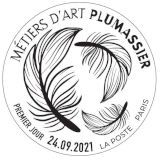TIMBRES DE FRANCE
Ex : 50 c
Ex : 456
Ex : Appel du 18 juin
Ex : 1900
Ex : Femme
mini 4 lettres
Création du site : Juillet 2005
Nombre de visiteurs : 34.962.616
Nombre de pages : 113.893.120
Dernière mise à jour 18-04-2025
Nombre de visiteurs : 34.962.616
Nombre de pages : 113.893.120
Dernière mise à jour 18-04-2025
Cette bannière est une publicité le site n'a aucune boutique de vente
Les informations sur ce timbre ont été mises à jour le : 10/12/2024

Métiers d'art
Le plumassier
D’après photos © Lycée Octave
Timbre : Bloc souvenir
Listage des timbres de l'année 2021




Cachet premier jour créé par : Hélène Cayre
Premier jour : Oblitération 1er jour au carré d'Encre 3 bis rue des Mathurins, 75009 PARIS le 24 et 25 septembre 2021
Vente générale : 27 septembre 2021
Valeur faciale : 1.50 €
Prix de vente : 4.50 €
Affranchissement le plus courant : Lettre prioritaire 20g pour l'international
Graveur : Line Filhon
Création : Hélène Cayre
Couleur : Multicolore
Mode d'impression : mixte offset taille-douce
Format du Bloc souvenir : 200 x 95 mm
Quantité émis : 30.000.
Présentation : Bloc souvenir
Bande phosphore : 2 barres
Catalogue Yvert et Tellier France : N° 181
Valeur marchande timbre neuf avec gomme intacte: 4,00 €
Valeur marchande timbre oblitéré : 4,00 €
La valeur marchande représente une valeur de base du timbre pour la vente ou l'échange
Thématique catégorie : Métiers
Informations sur le sujet du timbre
Elle existe sous l’Antiquité, et probablement dès la préhistoire, dans toutes les civilisations Elle orne les objets religieux ou rituels, le vêtement militaire, la mode, la décoration, le spectacle, la musique, la bijouterie, l’horlogerie. L’assemblage des plumes est assuré par le collage, la couture et la monture. Le brûlage, la découpe, le frisage, l’oxygénation, le parage, la teinture transforment leur aspect. La plume a souvent une valeur symbolique et sacrée
Très présente en Europe du XIIIe au XVIe siècle, elle ne cesse de se développer aux XVIIe et XVIIIe. Les techniques sont exposées dans L’Encyclopédie de Diderot et d’Alembert. Son...lire la suite
It exists in antiquity, and probably since prehistory, in all civilizations It adorns religious or ritual objects, military clothing, fashion, decoration, entertainment, music, jewelry, watchmaking. The feathers are assembled by gluing, sewing and setting. Burning, cutting, curling, oxygenating, trimming, dyeing transform their appearance. The pen often has a symbolic and sacred value
Very present in Europe from the thirteenth to the sixteenth century, it continues to develop in the seventeenth and eighteenth. The techniques are described in L'Encyclopédie de Diderot et d’Alembert. Its golden age goes from 1890 to the First World War. In the sixties, with the end of wearing a hat, it disappears for a while to be reborn at the end of the twentieth century when designers (Alexander McQueen, Philip Treacy, Stephen Jones, Jean-Paul Gaultier...) put it back in fashion. Today, plumage is practiced in the same way, even if technology offers new possibilities (new dyes and glues, laser burning and cutting). It is practiced in several types of workshops and artisans: those of fashion and haute couture, stage costume, cinema, opera and music hall, interior decoration and lighting, In the cabinets of curiosities and in workshops for watchmaking and jewellery.
Spurce © La Poste - Dominique Pilliard, plumassier and trainer at the Lycée Octave Sheet -All rights reserved
Source : various Internet documents including Wikipedia
Cette page a été visitée 14 822 649 fois depuis le 1er mai 2022
